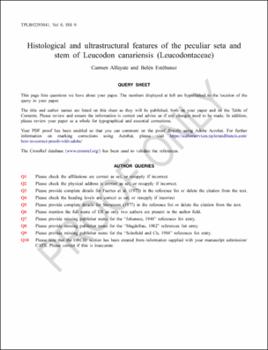Histological and ultrastructural features of the peculiar seta and stem of Leucodon canariensis (Leucodontaceae).
Fecha
2023Resumen
The seta and stem in Leucodon canariensis are examined by means of light microscopy, transmission and scanning electron microscopy. Their anatomies reveal relevant differences although both show a remarkable structural complexity, as their conducting tissues are equally effective in carrying out essential processes. Five types of cells have been recognized in the transverse sections: (i) in both seta and stem: stereids in the external region with a peripheral cuticle; (ii) in the stem only: parenchymatous cells with plasmodesmata underlying the stereids; in the seta only: (iii) an unusual area of nacreous-walled cells without live protoplasm, surrounding (iv) the food-conducting cells (leptoid-like), and again both in seta and stem: (v) hydroids in the internal region. The seta in this species has a peculiar organization and shares some characteristics with polytrichaceous mosses; the ultrastructural similarities and differences and functional significance of these cells are discussed, both systematically and in relation to the habit of the moss itself.





